何为Monad
来源:互联网 发布:顶点软件股票 编辑:程序博客网 时间:2024/05/22 06:05

Monad时学习Haskell函数式编程语言所必须要掌握的内容,stackoverflow中有两个对此的解释,比较抽象:
1)http://stackoverflow.com/questions/44965/what-is-a-monad
2)http://stackoverflow.com/questions/2704652/monad-in-plain-english-for-the-oop-programmer-with-no-fp-background
Aditya Bhargava有对此非常形象化的解释
http://adit.io/posts/2013-04-17-functors,_applicatives,_and_monads_in_pictures.html
都是很简单的英文,想看中文可以参考http://jiyinyiyong.github.io/monads-in-pictures/
Here’s a simple value: 
And we know how to apply a function to this value: 
Simple enough. Lets extend this by saying that any value can be in a context. For now you can think of a context as a box that you can put a value in:
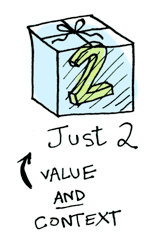
Now when you apply a function to this value, you’ll get different results depending on the context. This is the idea that Functors, Applicatives, Monads, Arrows etc are all based on. The Maybe data type defines two related contexts:

data Maybe a = Nothing | Just aIn a second we’ll see how function application is different when something is a Just a versus a Nothing. First let’s talk about Functors!
Functors
When a value is wrapped in a context, you can’t apply a normal function to it:

This is where fmap comes in. fmap is from the street, fmap is hip to contexts. fmap knows how to apply functions to values that are wrapped in a context. For example, suppose you want to apply (+3) to Just 2. Use fmap:
> fmap (+3) (Just 2)Just 5
Bam! fmap shows us how it’s done! But how does fmap know how to apply the function?
Just what is a Functor, really?
Functor is a typeclass. Here’s the definition:

A Functor is any data type that defines how fmap applies to it. Here’s how fmap works:

So we can do this:
> fmap (+3) (Just 2)Just 5And fmap magically applies this function, because Maybe is a Functor. It specifies how fmap applies to Justs and Nothings:
instance Functor Maybe where fmap func (Just val) = Just (func val) fmap func Nothing = NothingHere’s what is happening behind the scenes when we write fmap (+3) (Just 2):

So then you’re like, alright fmap, please apply (+3) to a Nothing?

> fmap (+3) NothingNothing
Bill O’Reilly being totally ignorant about the Maybe functor
Like Morpheus in the Matrix, fmap knows just what to do; you start with Nothing, and you end up with Nothing! fmap is zen. Now it makes sense why the Maybe data type exists. For example, here’s how you work with a database record in a language without Maybe:
post = Post.find_by_id(1)if post return post.titleelse return nilendBut in Haskell:
fmap (getPostTitle) (findPost 1)If findPost returns a post, we will get the title with getPostTitle. If it returns Nothing, we will return Nothing! Pretty neat, huh? <$> is the infix version of fmap, so you will often see this instead:
getPostTitle <$> (findPost 1)Here’s another example: what happens when you apply a function to a list?
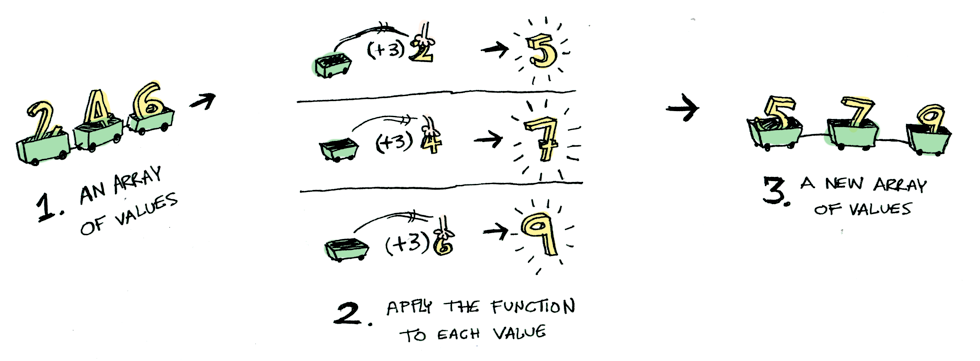
Lists are functors too! Here’s the definition:
instance Functor [] where fmap = mapOkay, okay, one last example: what happens when you apply a function to another function?
fmap (+3) (+1)Here’s a function:

Here’s a function applied to another function:
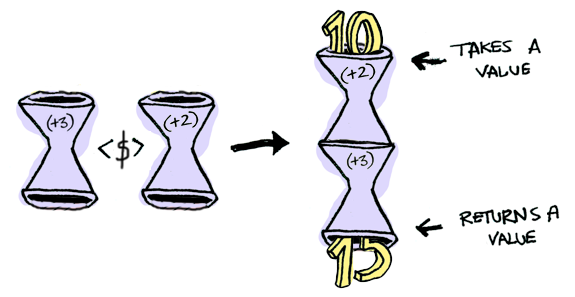
The result is just another function!
> import Control.Applicative> let foo = fmap (+3) (+2)> foo 1015So functions are Functors too!
instance Functor ((->) r) where fmap f g = f . gWhen you use fmap on a function, you’re just doing function composition!
Applicatives
Applicatives take it to the next level. With an applicative, our values are wrapped in a context, just like Functors:

But our functions are wrapped in a context too!
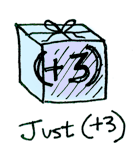
Yeah. Let that sink in. Applicatives don’t kid around. Control.Applicative defines <*>, which knows how to apply a function wrapped in a context to a value wrapped in a context:

i.e:
Just (+3) <*> Just 2 == Just 5Using <*> can lead to some interesting situations. For example:
> [(*2), (+3)] <*> [1, 2, 3][2, 4, 6, 4, 5, 6]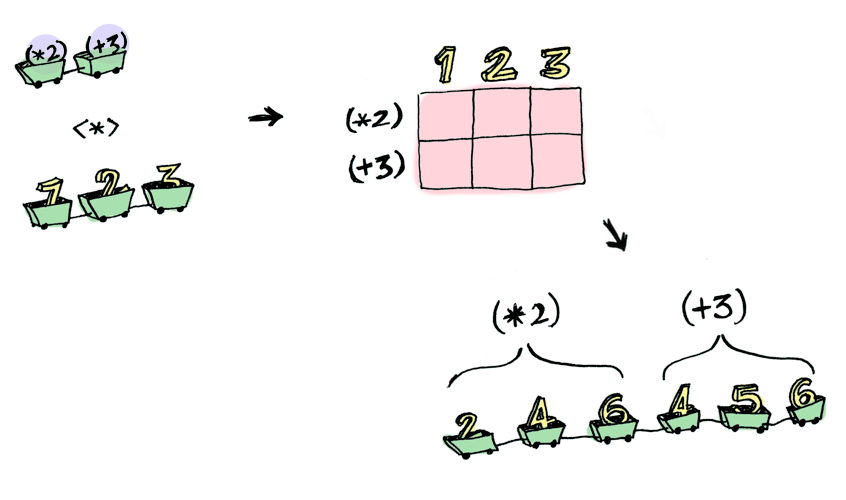
Here’s something you can do with Applicatives that you can’t do with Functors. How do you apply a function that takes two arguments to two wrapped values?
> (+) <$> (Just 5)Just (+5)> Just (+5) <$> (Just 4)ERROR ??? WHAT DOES THIS EVEN MEAN WHY IS THE FUNCTION WRAPPED IN A JUSTApplicatives:
> (+) <$> (Just 5)Just (+5)> Just (+5) <*> (Just 3)Just 8Applicative pushes Functor aside. “Big boys can use functions with any number of arguments,” it says. “Armed <$> and <*>, I can take any function that expects any number of unwrapped values. Then I pass it all wrapped values, and I get a wrapped value out! AHAHAHAHAH!”
> (*) <$> Just 5 <*> Just 3Just 15And hey! There’s a function called liftA2 that does the same thing:
> liftA2 (*) (Just 5) (Just 3)Just 15Monads
How to learn about Monads:
- Get a PhD in computer science.
- Throw it away because you don’t need it for this section!
Monads add a new twist.
Functors apply a function to a wrapped value:

Applicatives apply a wrapped function to a wrapped value:
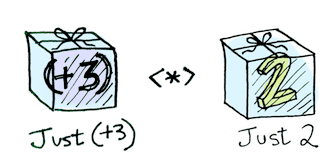
Monads apply a function that returns a wrapped value to a wrapped value. Monads have a function >>= (pronounced “bind”) to do this.
Let’s see an example. Good ol’ Maybe is a monad:

Just a monad hanging out
Suppose half is a function that only works on even numbers:
half x = if even x then Just (x `div` 2) else Nothing
What if we feed it a wrapped value?

We need to use >>= to shove our wrapped value into the function. Here’s a photo of >>=:

Here’s how it works:
> Just 3 >>= halfNothing> Just 4 >>= halfJust 2> Nothing >>= halfNothingWhat’s happening inside? Monad is another typeclass. Here’s a partial definition:
class Monad m where (>>=) :: m a -> (a -> m b) -> m bWhere >>= is:

So Maybe is a Monad:
instance Monad Maybe where Nothing >>= func = Nothing Just val >>= func = func valHere it is in action with a Just 3!
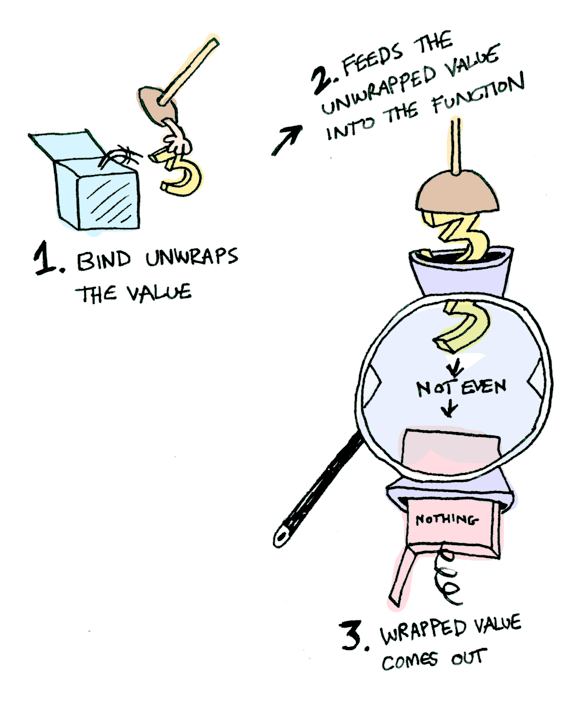
And if you pass in a Nothing it’s even simpler:
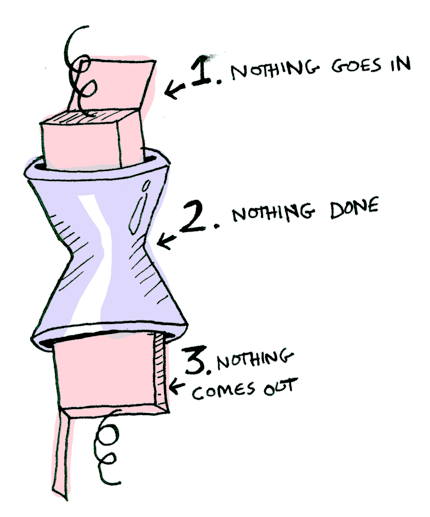
You can also chain these calls:
> Just 20 >>= half >>= half >>= halfNothing

Cool stuff! So now we know that Maybe is a Functor, an Applicative, and a Monad.
Now let’s mosey on over to another example: the IO monad:

Specifically three functions. getLine takes no arguments and gets user input:

getLine :: IO StringreadFile takes a string (a filename) and returns that file’s contents:
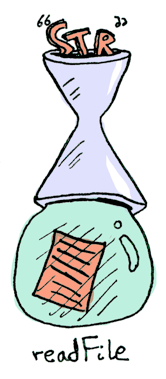
readFile :: FilePath -> IO StringputStrLn takes a string and prints it:
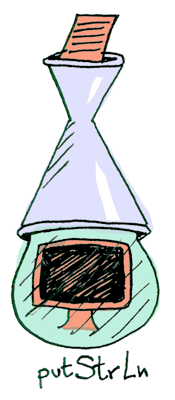
putStrLn :: String -> IO ()All three functions take a regular value (or no value) and return a wrapped value. We can chain all of these using >>=!

getLine >>= readFile >>= putStrLnAw yeah! Front row seats to the monad show!
Haskell also provides us with some syntactical sugar for monads, called do notation:
foo = do filename <- getLine contents <- readFile filename putStrLn contentsConclusion
- A functor is a data type that implements the
Functortypeclass. - An applicative is a data type that implements the
Applicativetypeclass. - A monad is a data type that implements the
Monadtypeclass. - A
Maybeimplements all three, so it is a functor, an applicative, and a monad.
What is the difference between the three?

- functors: you apply a function to a wrapped value using
fmapor<$> - applicatives: you apply a wrapped function to a wrapped value using
<*>orliftA - monads: you apply a function that returns a wrapped value, to a wrapped value using
>>=orliftM
So, dear friend (I think we are friends by this point), I think we both agree that monads are easy and a SMART IDEA(tm). Now that you’ve wet your whistle on this guide, why not pull a Mel Gibson and grab the whole bottle. Check out LYAH’s section on Monads. There’s a lot of things I’ve glossed over because Miran does a great job going in-depth with this stuff.
- 何为Monad
- Monad
- Monad
- Monad到底为程序设计带来啥好处
- 人生何为苦何为乐何为幸福
- 何为天,何为地,何为道
- 何为输入,何为输出?
- 何为声明 何为定义
- 何为debug 何为 release
- 何为堆?何为栈?
- haskell Monad: Status Monad
- 何为博客?
- 笑话--何为男人?
- 何为Robocode
- 何为DMZ区
- 何为“线速”?
- 何为日货
- 何为LE
- MFC实现贪吃蛇小游戏
- java排序之 选择排序
- TypeScript实现贪吃蛇小游戏
- WebStorm2016.1 破解 激活
- (转)关于尾递归的解释
- 何为Monad
- iperf3已不再支持双工模式测试
- Nginx报错403 forbidden (13: Permission denied)的解决办法
- Node.js中如何处理耗时长的任务
- C++编写Node.js插件(Addon)
- 服务核心
- 学习scala: Hello World
- unity简易字符雨材质
- 将一个文件分割(1M)和合并


